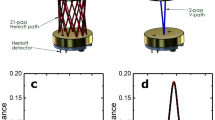Abstract
The monitoring of respiratory and anesthetic gases in the operating room is important for patient safety. This study measured the accuracy and response time of a multiplegas monitoring instrument that uses Raman light scattering. Measurements of oxygen, carbon dioxide, nitrogen, nitrous oxide, halothane, enflurane, and isoflurane concentrations were compared with a gas mixer standard and with measurements made with an infrared anesthetic agent analyzer. Correlation coefficients were all greater than 0.999, and probable errors were less than 0.43 vol% for the gases and less than 0.03 vol% for the volatile anesthetics. Response time was 67 ms with a sample flow rate of 150 ml/min. There was some signal overlap between nitrogen and nitrous oxide and between the volatile anesthetic agents. Such overlap can be compensated for by linear matrix analysis. The Raman instrument promises a monitoring capability equivalent to the mass spectrometer and should prove attractive for the monitoring of respiratory and anesthetic gases in the operating room.
Similar content being viewed by others
References
Gravenstein JS, Paulus DA. Monitoring practice in clinical anesthesia. Philadelphia: Lippincott, 1982:147–165
Rendell-Baker L. Problems with anesthetic gas machines and their solutions. In: Rendell-Baker L, ed. Problems with anesthetic and respiratory therapy equipment. Int Anesthesiol Clin 1982;20:l-82
Calkins JM. Monitoring system gas concentrations. In: Brown BR Jr, ed. Future anesthesia delivery systems: contemporary anesthesia practice. Philadelphia: F.A. Davis, 1984:137–145
Saidman LJ, Smith NT. Monitoring in anesthesia. New York: Wiley, 1978
Gravenstein JS, Newbower RS, Ream AK, Smith NT, eds. Monitoring surgical patients in the operating room. Springfield, IL: Charles C Thomas, 1979
ANSI Z 79.8 paragraph 16.1.2.1 American National Standards Committee 279. 1430 Broadway NY, NY 10018
Peters RM. Monitoring of ventilation in the anesthetized patient. In: Gravenstein JS, Newbower RS, Ream AK, Smith NT, eds. Monitoring surgical patients in the operating room. Springfield, IL: Thomas, 1979:142–151
Long DA. Raman spectroscopy. New York: McGraw-Hill, 1977
Schrotter HW, Klockner HW. Raman scattering cross sections in gases and liquids. In: Weber A, ed. Raman spectroscopy of gases and liquids. New York: Springer-Verlag, 1979:123–166
Wallace WD, Clark JS, Cutler CA. Blood-gas analyzer calibration and quality control using a precision gasmixing instrument. Respir Care 1981:26:757–761
Colquhoun AD, Gray WM, Asbury AJ. An evaluation of the Datex Normac anaesthetic agent monitor. Anaesthesia 1986;41:198–204
Cerni RH, Foster LE. Measurement accuracy and precision and error. In: Dalley JW, Riley WF, eds. Instrumentation for engineering measurement. New York: Wiley, 1962:23–37
Graham AR. The static performance of instruments. In: Graham R, ed. An introduction to engineering measurements. Englewood Cliffs, NJ: Prentice-Hall, 1975:54–79
Gravenstein N, Lampotang S, Beneken JEW. Factors influencing capnography in the Bain circuit. J Clin Monit 1985;l:6–10
Sasse FJ. Can we trust end-tidal carbon dioxide measurements in infants? J Clin Monit 1985;1:147–148
Frans SD, Harris JM: Selection of analytical wavelengths for multicomponent spectrophotometric determinations. Ann Chem 1985;57:2680–2684
Author information
Authors and Affiliations
Rights and permissions
About this article
Cite this article
Van Wagenen, R.A., Westenskow, D.R., Benner, R.E. et al. Dedicated monitoring of anesthetic and respiratory gases By Raman scattering. J Clin Monitor Comput 2, 215–222 (1986). https://doi.org/10.1007/BF02851168
Received:
Revised:
Accepted:
Issue Date:
DOI: https://doi.org/10.1007/BF02851168




